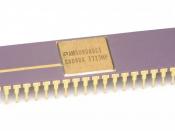Contents1.Introduction32.Lessons learnt from past mistakes33.Intel Architecture Group: Beyond 200353.1Challenges and threats54.Intel's diversification into communications74.1Strategic logic74.2Strategic challenges85.Looking to the future: Intel in five years106.Conclusion117.References121.IntroductionIntel Corporation has become famous in business circles for its major strategic adjustment in the mid-1980's. The company abandoned its lucrative memory chip manufacturing business in the face of increased Japanese competition, and focused on the sales of microprocessors for PCs. The company faced a similar strategic inflection point at the beginning of the 21st century, caused by the threat of diminishing PC sales and increasing competition from its chief rival, Advanced Micro Devices (AMD). Intel's initial attempts to diversify its portfolio from microprocessors to mitigate these effects largely failed. The company's executive management had to provide a solution to the problem of diversifying a company that had been built on the success of a core product technology.
Intel's challenge for the future was to leverage its existing assets of manufacturing and technological prowess for the required diversification, while at the same time avoiding being stifled and limited by the focus of its past successes and encouraging innovation and learning.
2.Lessons learnt from past mistakesFrom 1998, Intel attempted to diversify its portfolio, and made significant investments in non-core industries such as online internet services and hosting facilities. Most of these investments were failures, and the company ended up closing a lot of these new businesses.
Intel's top management took the opportunity to learn from their mistakes, turning these failures into 'productive failures' (Burgelman, Christensen & Wheelwright, 2004). The company learnt that a strategy of diversification can and should still take advantage of the core competencies and technologies of existing products and must be complemented by a change of corporate culture to embrace organizational learning and new...


